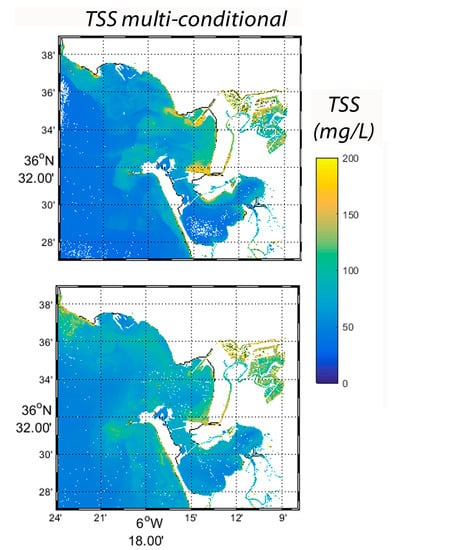Evaluation of the First Year of Operational Sentinel-2A Data for Retrieval of Suspended Solids in Medium- to High-Turbidity Waters
Abstract
:1. Introduction
2. Materials and Methods
2.1. Study Area
2.2. Sentinel-2 Imagery
2.3. Atmospheric Correction Methodologies
2.4. In-Situ TSS Data
2.5. Selection of the Multi-Conditional TSS Algorithm
3. Results
3.1. Multi-Conditional Algorithm
3.2. Analysis of the Atmospheric Correction Strategies
3.3. Application of the TSS Multi-Conditional Algorithm
4. Discussion
5. Conclusions
Supplementary Materials
Author Contributions
Acknowledgments
Conflicts of Interest
References
- Halpern, B.S.; McLeod, K.L.; Rosenberg, A.A.; Crowder, L.B. Managing for cumulative impacts in ecosystem-based management through ocean zoning. Ocean Coast. Manag. 2008, 51, 203–211. [Google Scholar] [CrossRef]
- Becker, A.; Whitfield, A.K.; Cowley, P.D.; Järnegren, J.; Næsje, T.F. Potential effects of artificial light associated with anthropogenic infrastructure on the abundance and foraging behavior of estuary-associated fishes. Appl. Ecol. 2013, 50, 43–50. [Google Scholar] [CrossRef]
- Ouellette, W.; Getinet, W. Remote sensing for marine spatial planning and integrated coastal areas management: Achievements, challenges, opportunities and future prospects. Remote Sens. Appl. Soc. Environ. 2016, 4, 138–157. [Google Scholar] [CrossRef]
- International Ocean-Colour Coordinating Group. Mission Requirements for Future Ocean-Colour Sensors; McClain, C.R., Meister, G., Eds.; IOCCG Report 13; International Ocean-Colour Coordinating Group: Dartmouth, NS, Canada, 2012; p. 106. [Google Scholar]
- Cloern, J.E. Turbidity as a control on phytoplankton biomass and productivity in estuaries. Cont. Shelf Res. 1987, 7, 1367–1381. [Google Scholar] [CrossRef]
- Malenovský, Z.; Rott, H.; Cihlar, J.; Schaepman, M.E.; García-Santos, G.; Fernandes, R.; Berger, M. Sentinels for science: Potential of Sentinel-1, -2, and-3 missions for scientific observations of ocean, cryosphere, and land. Remote Sens. Environ. 2012, 120, 91–101. [Google Scholar] [CrossRef]
- Du, Y.; Zhang, Y.; Ling, F.; Wang, Q.; Li, W.; Li, X. Water bodies’ mapping from Sentinel-2 imagery with modified normalized difference water index at 10-m spatial resolution produced by sharpening the SWIR band. Remote Sens. 2016, 8, 354. [Google Scholar] [CrossRef] [Green Version]
- Dörnhöfer, K.; Gege, P.; Pflug, B.; Oppelt, N. Mapping indicators of lake ecology at lake Starnberg, Germany—First results of Sentinel-2A. In Proceedings of the Living Planet Symposium 2016, Prague, Czech Republic, 9–13 May 2016; pp. 1–8. [Google Scholar]
- Dörnhöfer, K.; Göritz, A.; Gege, P.; Pflug, B.; Oppelt, N. Water constituents and water depth retrieval from Sentinel-2A—A first evaluation in an oligotrophic lake. Remote Sens. 2016, 8, 941. [Google Scholar] [CrossRef]
- Toming, K.; Kutser, T.; Laas, A.; Sepp, M.; Paavel, B.; Nõges, T. First experiences in mapping lake water quality parameters with Sentinel-2 MSI imagery. Remote Sens. 2016, 8, 640. [Google Scholar] [CrossRef]
- Martins, V.S.; Barbosa, C.C.F.; de Carvalho, L.A.S.; Jorge, D.S.F.; Lobo, F.d.L.; Novo, E.M.L.d.M. Assessment of atmospheric correction methods for Sentinel-2 MSI images applied to Amazon floodplain lakes. Remote Sens. 2017, 9, 322. [Google Scholar] [CrossRef]
- Vanhellemont, Q.; Ruddick, K. ACOLITE for Sentinel-2: Aquatic applications of MSI imagery. In Proceedings of the ESA Living Planet Symposium, Prague, Czech Republic, 9–13 May 2016. ESA Special Publication SP-740. [Google Scholar]
- Ruddick, K.; Vanhellemont, Q.; Dogliotti, A.; Nechad, B.; Pringle, N.; Van der Zande, D. New opportunities and challenges for high resolution remote sensing of water colour. In Proceedings of the Ocean Optics XXIII, Victoria, BC, Canada, 23–28 October 2016; pp. 23–28. [Google Scholar]
- Serra, R.; Mangin, A.; Fanton d’Andon, O.H.; Lauters, F.; Thomasset, F.; Martin-Lauzer, F.-R. Biological status monitoring of European fresh water with Sentinel-2. In Proceedings of the Living Planet Symposium 2016, Prague, Czech Republic, 9–13 May 2016; Volume 740, p. 250. [Google Scholar]
- Navarro, G.; Caballero, I.; Vazquez, A. Sentinel-2 imagery for tuna fishing management high spatial resolution satellite images for Spain’s almadraba fishery. Sea Technol. 2016, 57, 29–31. [Google Scholar]
- Pahlevan, N.; Sarkar, S.; Franz, B.; Balasubramanian, S.; He, J. Sentinel-2 multispectral instrument (MSI) data processing for aquatic science applications: Demonstrations and validations. Remote Sens. Environ. 2017, 201, 47–56. [Google Scholar] [CrossRef]
- Vanhellemont, Q.; Ruddick, K. Advantages of high quality SWIR bands for ocean colour processing: Examples from Landsat-8. Remote Sens. Environ. 2015, 161, 89–106. [Google Scholar] [CrossRef]
- Ruddick, K.G.; Ovidio, F.; Rijkeboer, M. Atmospheric correction of SeaWiFS imagery for turbid coastal and inland waters. Appl. Opt. 2000, 39, 897–912. [Google Scholar] [CrossRef] [PubMed]
- Hu, C.; Carder, K.L.; Muller-Karger, F.E. Atmospheric correction of SeaWiFS imagery over turbid coastal waters: A practical method. Remote Sens. Environ. 2000, 74, 195–206. [Google Scholar] [CrossRef]
- Vanhellemont, Q.; Ruddick, K. Turbid wakes associated with offshore wind turbines observed with Landsat 8. Remote Sens. Environ. 2014, 145, 105–115. [Google Scholar] [CrossRef]
- Wang, M.; Shi, W. Estimation of ocean contribution at the MODIS near-infrared wavelengths along the east coast of the US: Two case studies. Geophys. Res. Lett. 2005, 32. [Google Scholar] [CrossRef]
- Steinmetz, F.; Deschamps, P.-Y.; Ramon, D. Atmospheric correction in presence of sun glint: Application to MERIS. Opt. Express 2011, 19, 9783–9800. [Google Scholar] [CrossRef] [PubMed]
- Traganos, D.; Reinartz, P. Mapping Mediterranean seagrasses with Sentinel-2 imagery. Mar. Pollut. Bull. 2017. [Google Scholar] [CrossRef] [PubMed]
- Masek, J.; Vermote, E.; Franch, B.; Roger, J.-C.; Skakun, S.; Claverie, M.; Dungan, J. Harmonizing Landsat and Sentinel-2 Reflectances for Better Land Monitoring; Technical Report; National Aeronautics and Space Administration (NASA): Washington, DC, USA, 2016. [Google Scholar]
- Ruiz, J.; Polo, M.J.; Díez-Minguito, M.; Navarro, G.; Morris, E.P.; Huertas, E.; Caballero, I.; Contreras, E.; Losada, M.A. The Guadalquivir estuary: A hot spot for environmental and human conflicts. In Environmental Management and Governance; Springer: Berlin, Germany, 2015; pp. 199–232. [Google Scholar]
- Carrasco, M.; Lopez-Ramırez, J.; Benavente, J.; López-Aguayo, F.; Sales, D. Assessment of urban and industrial contamination levels in the Bay of Cádiz, SW Spain. Mar. Pollut. Bull. 2003, 46, 335–345. [Google Scholar] [CrossRef]
- Caballero, I.; Navarro, G. Dynamics of the turbidity plume in the Guadalquivir estuary coastal region: Observations from in-situ to remote sensing data. In Proceedings of the ESA Living Planet Symposium, Prague, Czech Republic, 9–13 May 2016. [Google Scholar]
- Caballero, I.; Morris, E.; Prieto, L.; Navarro, G. The influence of the Guadalquivir River on spatio-temporal variability of suspended solids and chlorophyll in the eastern Gulf of Cádiz. Mediterr. Mar. Sci. 2014, 15, 721–738. [Google Scholar] [CrossRef]
- Nechad, B.; Ruddick, K.; Park, Y. Calibration and validation of a generic multisensor algorithm for mapping of total suspended matter in turbid waters. Remote Sens. Environ. 2010, 114, 854–866. [Google Scholar] [CrossRef]
- Caballero, I.; Morris, E.P.; Ruiz, J.; Navarro, G. Assessment of suspended solids in the Guadalquivir estuary using new DEIMOS-1 medium spatial resolution imagery. Remote Sens. Environ. 2014, 146, 148–158. [Google Scholar] [CrossRef] [Green Version]
- Doxaran, D.; Froidefond, J.-M.; Lavender, S.; Castaing, P. Spectral signature of highly turbid waters: Application with spot data to quantify suspended particulate matter concentrations. Remote Sens. Environ. 2002, 81, 149–161. [Google Scholar] [CrossRef]
- Doxaran, D.; Froidefond, J.-M.; Castaing, P.; Babin, M. Dynamics of the turbidity maximum zone in a macrotidal estuary (The Gironde, France): Observations from field and MODIS satellite data. Estuar. Coast. Shelf Sci. 2009, 81, 321–332. [Google Scholar] [CrossRef]
- Dogliotti, A.I.; Ruddick, K.; Nechad, B.; Doxaran, D.; Knaeps, E. A single algorithm to retrieve turbidity from remotely-sensed data in all coastal and estuarine waters. Remote Sens. Environ. 2015, 156, 157–168. [Google Scholar] [CrossRef]
- Bowers, D.; Braithwaite, K.; Nimmo-Smith, W.; Graham, G. Light scattering by particles suspended in the sea: The role of particle size and density. Cont. Shelf Res. 2009, 29, 1748–1755. [Google Scholar] [CrossRef]
- Feng, L.; Hu, C.; Chen, X.; Song, Q. Influence of the three gorges dam on total suspended matters in the Yangtze estuary and its adjacent coastal waters: Observations from MODIS. Remote Sens. Environ. 2014, 140, 779–788. [Google Scholar] [CrossRef]
- Han, B.; Loisel, H.; Vantrepotte, V.; Mériaux, X.; Bryère, P.; Ouillon, S.; Dessailly, D.; Xing, Q.; Zhu, J. Development of a semi-analytical algorithm for the retrieval of suspended particulate matter from remote sensing over clear to very turbid waters. Remote Sens. 2016, 8, 211. [Google Scholar] [CrossRef]
- Novoa, S.; Doxaran, D.; Ody, A.; Vanhellemont, Q.; Lafon, V.; Lubac, B.; Gernez, P. Atmospheric corrections and multi-conditional algorithm for multi-sensor remote sensing of suspended particulate matter in low-to-high turbidity levels coastal waters. Remote Sens. 2017, 9, 61. [Google Scholar] [CrossRef]
- Navarro, G.; Huertas, I.E.; Costas, E.; Flecha, S.; Díez-Minguito, M.; Caballero, I.; López-Rodas, V.; Prieto, L.; Ruiz, J. Use of a real-time remote monitoring network (RTRM) to characterize the Guadalquivir estuary (Spain). Sensors 2012, 12, 1398–1421. [Google Scholar] [CrossRef] [PubMed] [Green Version]
- Álvarez, O.; Tejedor, B.; Vidal, J. La dinámica de marea en el estuario del Guadalquivir: Un caso peculiar de resonancia antrópica. Física de la Tierra 2001, 13, 11–24. [Google Scholar]
- Contreras, E.; Polo, M. Measurement frequency and sampling spatial domains required to characterize turbidity and salinity events in the Guadalquivir estuary (Spain). Nat. Hazards Earth Syst. Sci. 2012, 12, 2581–2589. [Google Scholar] [CrossRef] [Green Version]
- Díez-Minguito, M.; Baquerizo, A.; Ortega-Sánchez, M.; Navarro, G.; Losada, M. Tide transformation in the Guadalquivir estuary (SW Spain) and process-based zonation. J. Geophys. Res. Oceans 2012, 117. [Google Scholar] [CrossRef] [Green Version]
- Vargas, J.; Paneque, P. Major hydraulic projects, coalitions and conflict. Seville’s harbour and the dredging of the Guadalquivir (Spain). Water 2015, 7, 6736–6749. [Google Scholar] [CrossRef]
- Ruiz, J.; González-Quirós, R.; Prieto, L.; Navarro, G. A bayesian model for anchovy (Engraulis encrasicolus): The combined forcing of man and environment. Fish. Oceanogr. 2009, 18, 62–76. [Google Scholar] [CrossRef]
- Prieto, L.; Navarro, G.; Rodríguez-Gálvez, S.; Huertas, I.; Naranjo, J.; Ruiz, J. Oceanographic and meteorological forcing of the pelagic ecosystem on the Gulf of Cadiz shelf (SW Iberian peninsula). Cont. Shelf Res. 2009, 29, 2122–2137. [Google Scholar] [CrossRef]
- Donázar-Aramendía, I.I.; Sanchez-Moyano, J.E.; García-Asencio, I.; Miró, J.M.; Megina, C.; García-Gómez, J.C. Impacts of dredged-material disposal on the soft-bottom communities in a marine dumping area near to Guadalquivir estuary, Spain. Front. Mar. Sci. 2016. [Google Scholar] [CrossRef] [PubMed]
- Bhat, A.; Blomquist, W. Policy, politics, and water management in the Guadalquivir river basin, Spain. Water Resour. Res. 2004, 40. [Google Scholar] [CrossRef]
- Rodríguez-Ramírez, A. The impact of man on the morphodynamics of the Huelva coast (SW Spain). J. Iber. Geol. 2008, 34, 313–327. [Google Scholar]
- Peralta, G.; Pérez-Lloréns, J.; Hernández, I.; Vergara, J. Effects of light availability on growth, architecture and nutrient content of the seagrass Zostera noltii Hornem. J. Exp. Mar. Biol. Ecol. 2002, 269, 9–26. [Google Scholar] [CrossRef]
- Muñoz Pérez, J.; Sánchez-Lamadrid, A. Medio fısico y biológico de la Bahia de Cádiz: Saco interior. Junta de Andalucía. Consejería de Agricultura y Pesca, Ed. Informaciones Técnicas 1994, 28, 161. [Google Scholar]
- Román, J.P.; Achab, M. Grain-size trends associated with sediment transport patterns in Cadiz bay (southwest Iberian Peninsula). Boletin Instituto Español de Oceanografía 1999, 15, 269–282. [Google Scholar]
- Achab, M. Dynamics of Sediments Exchange and Transport in the Bay of Cadiz and the Adjacent Continental Shelf (SW-Spain); Sediment Transport in Aquatic Environments; InTech: Rijeka, Croatia, 2011. [Google Scholar]
- Fettweis, M.P.; Nechad, B. Evaluation of in situ and remote sensing sampling methods for SPM concentrations, Belgian continental shelf (Southern North Sea). Ocean Dyn. 2011, 61, 157–171. [Google Scholar] [CrossRef]
- The United Nations Educational, Scientific and Cultural Organization (UNESCO). Protocols for the Joint Global Ocean Flux Study (JGOFS) Core Measurements; IOC Manuals and Guides; UNESCO: Paris, France, 1994; p. 170. [Google Scholar]
- Navarro, G.; Gutiérrez, F.J.; Díez-Minguito, M.; Losada, M.A.; Ruiz, J. Temporal and spatial variability in the Guadalquivir estuary: A challenge for real-time telemetry. Ocean Dyn. 2011, 61, 753–765. [Google Scholar] [CrossRef]
- Picard, R.R.; Cook, R.D. Cross-validation of regression models. J. Am. Stat. Assoc. 1984, 79, 575–583. [Google Scholar] [CrossRef]
- Contreras, E.; Polo, M. Capítulo 2: Aportes desde las cuencas vertientes. In Propuesta Metodológica Para Diagnosticar y Pronosticar las Consecuencias de las Actuaciones Humanas en el Estuario del Guadalquivir; Group of Fluvial Dynamic and Hydrology, University of Córdoba: Córdoba, Spain, 2010. [Google Scholar]
- Flecha, S.; Huertas, I.E.; Navarro, G.; Morris, E.P.; Ruiz, J. Air–water CO2 fluxes in a highly heterotrophic estuary. Estuar. Coast. 2015, 38, 2295–2309. [Google Scholar] [CrossRef]
- Müller, D.; Krasemann, H.; Brewin, R.J.; Brockmann, C.; Deschamps, P.-Y.; Doerffer, R.; Fomferra, N.; Franz, B.A.; Grant, M.G.; Groom, S.B. The ocean colour climate change initiative: I. A methodology for assessing atmospheric correction processors based on in-situ measurements. Remote Sens. Environ. 2015, 162, 242–256. [Google Scholar] [CrossRef]
- Frouin, R.; Deschamps, P.-Y.; Ramon, D.; Steinmetz, F. Improved ocean-color remote sensing in the arctic using the polymer algorithm. In Remote Sensing of the Marine Environment II; International Society for Optics and Photonics: Bellingham, WA, USA, 2012; p. 852. [Google Scholar] [CrossRef]
- Palanques, A.; Diaz, J.; Farran, M. Contamination of heavy metals in the suspended and surface sediment of the gulf of Cadiz (Spain): The role of sources, currents, pathways and sinks. Oceanol. Acta 1995, 18, 469–477. [Google Scholar]
- Machado, A.; Rocha, F.; Gomes, C.; Dias, J.; Araújo, M.; Gouveia, A. Mineralogical and geochemical characterisation of surficial sediments from the southwestern Iberian continental shelf. Thalassas 2005, 21, 67–76. [Google Scholar] [CrossRef]
- Caballero, I.C. Estudio de Procesos en la Desembocadura del Guadalquivir y Golfo de Cádiz: Variabilidad Espacio-Temporal Mediante Teledetección; Universidad de Granada: Granada, Spain, 2015. [Google Scholar]
- Bustamante, J.; Pacios, F.; Díaz-Delgado, R.; Aragonés, D. Predictive models of turbidity and water depth in the Doñana marshes using Landsat TM and ETM+ images. J. Environ. Manag. 2009, 90, 2219–2225. [Google Scholar] [CrossRef] [PubMed]
- Ruddick, K.G.; De Cauwer, V.; Park, Y.-J.; Moore, G. Seaborne measurements of near infrared water-leaving reflectance: The similarity spectrum for turbid waters. Limnol. Oceanogr. 2006, 51, 1167–1179. [Google Scholar] [CrossRef] [Green Version]
- Ruescas, A.; Pereira-Sandoval, M.; Tenjo, C.; Ruiz-Verdú, A.; Steinmetz, F.; De Keukelaere, L. Sentinel-2 atmospheric correction inter-comparison over two lakes in Spain and Peru-Bolivia. In Proceedings of the Colour and Light in the Ocean from Earth Observation (CLEO) Workshop, Frascati, Italy, 6–8 September 2016; ESA-ESRIN: Frascati/Rome, Italy, 2016. [Google Scholar]
- Díez-Minguito, M.; Baquerizo, A.; de Swart, H.; Losada, M. Structure of the turbidity field in the Guadalquivir estuary: Analysis of observations and a box model approach. J. Geophys. Res. Oceans 2014, 119, 7190–7204. [Google Scholar] [CrossRef] [Green Version]
- Caballero, I.; Navarro, G.; Ruiz, J. Multi-platform assessment of turbidity plumes during dredging operations in a major estuarine system. Int. J. Appl. Earth Obs. Geoinf. 2018, 68, 31–41. [Google Scholar] [CrossRef]
- Neukermans, G.; Ruddick, K.; Greenwood, N. Diurnal variability of turbidity and light attenuation in the southern North Sea from the SEVIRI geostationary sensor. Remote Sens. Environ. 2012, 124, 564–580. [Google Scholar] [CrossRef]
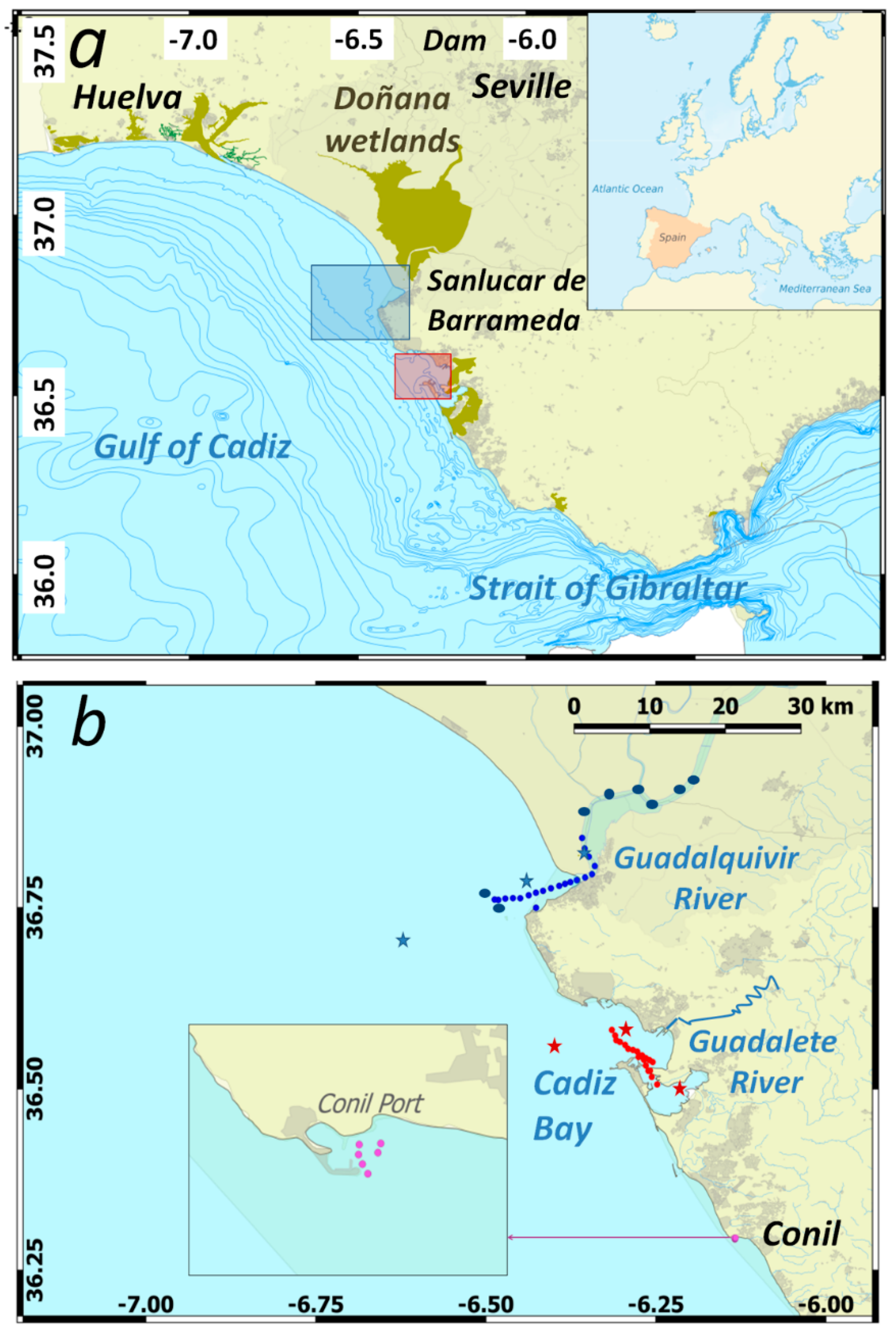
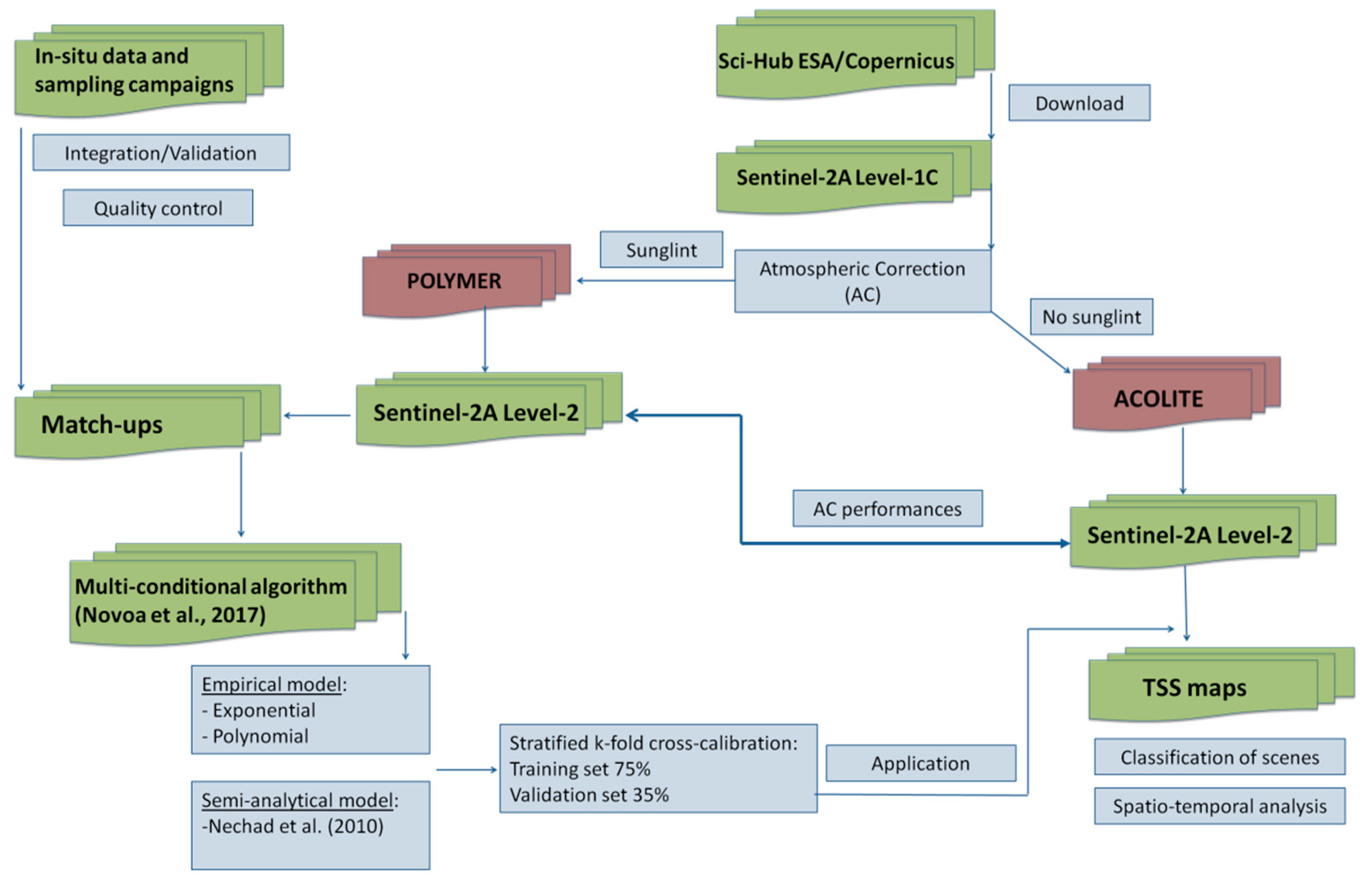
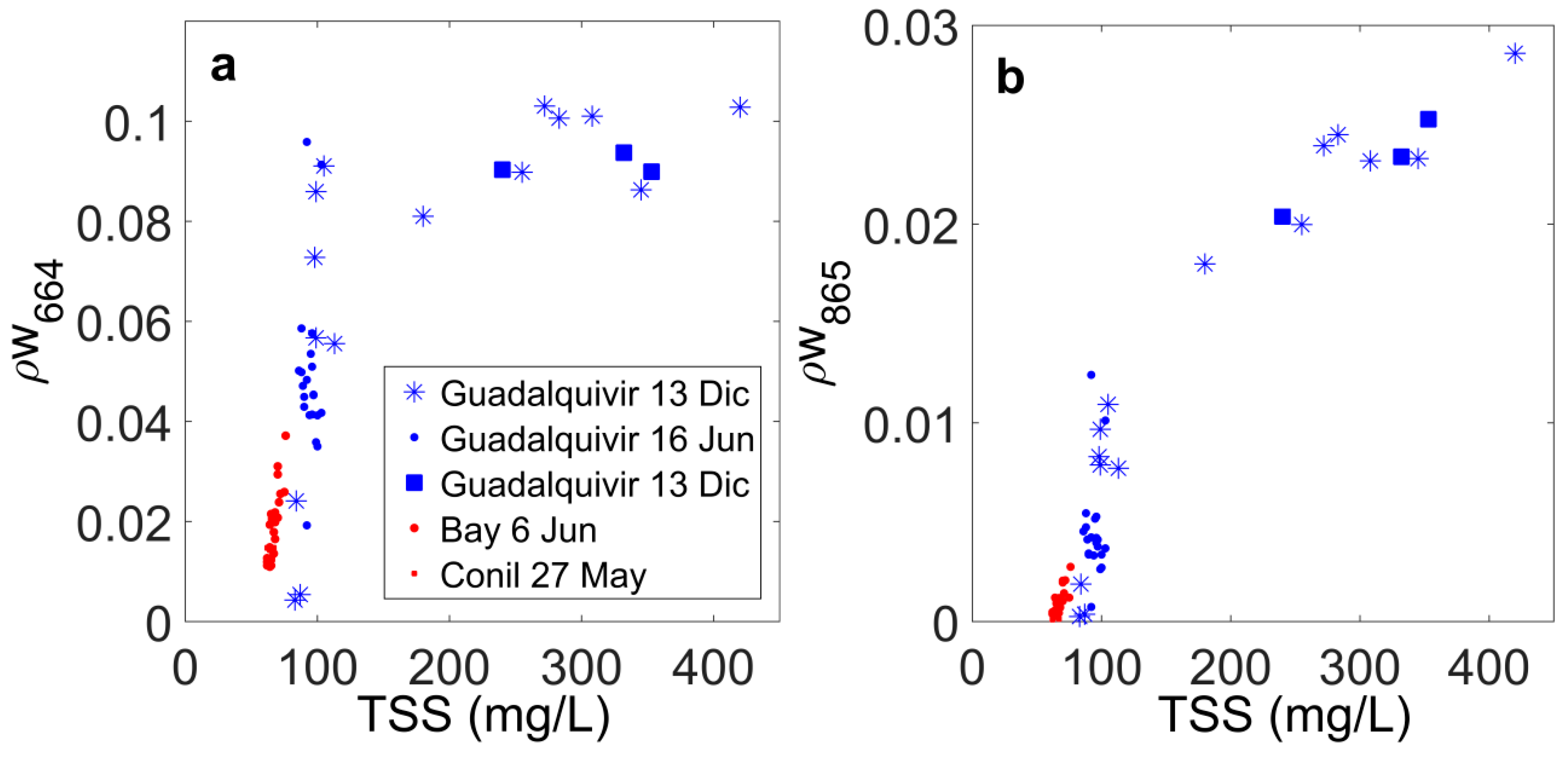
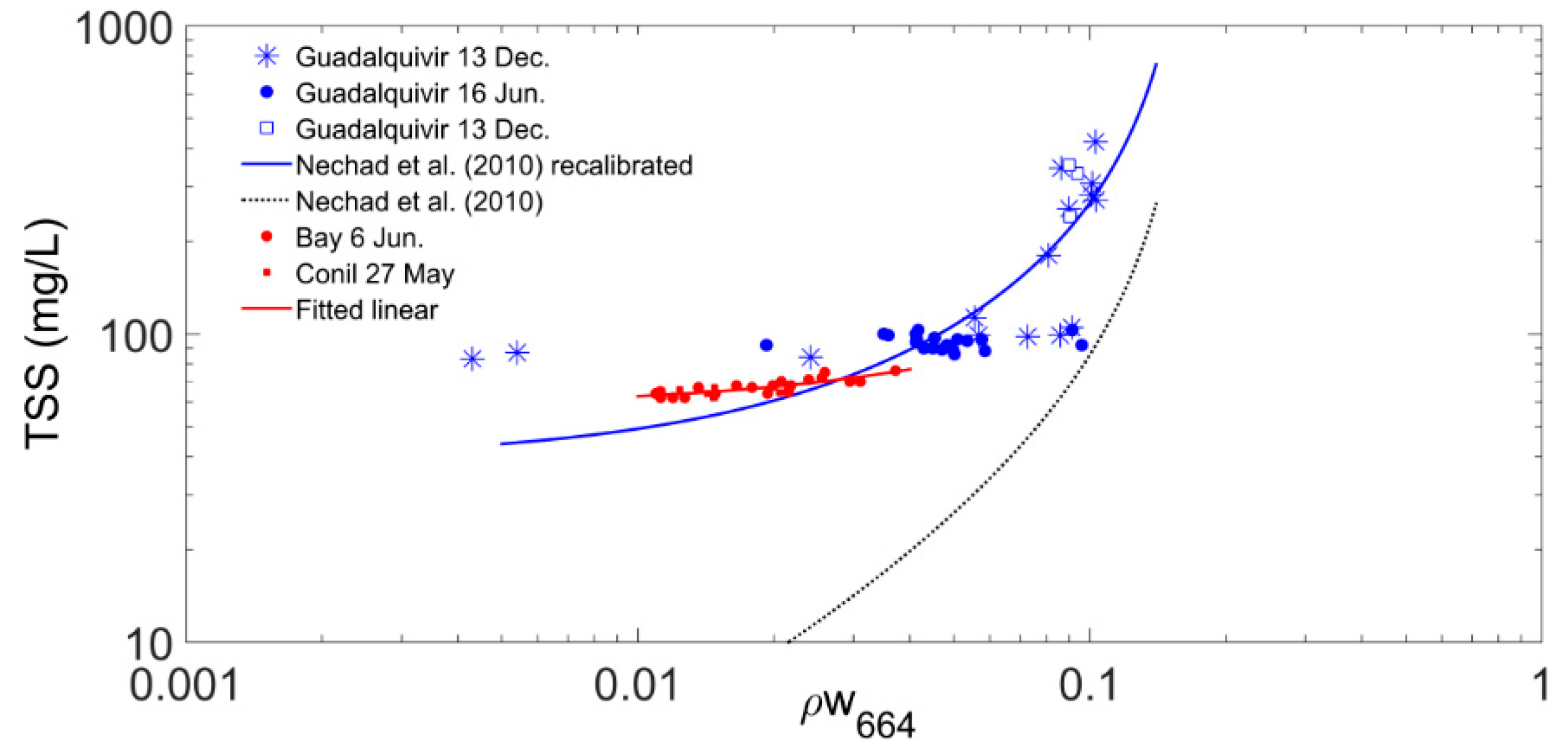
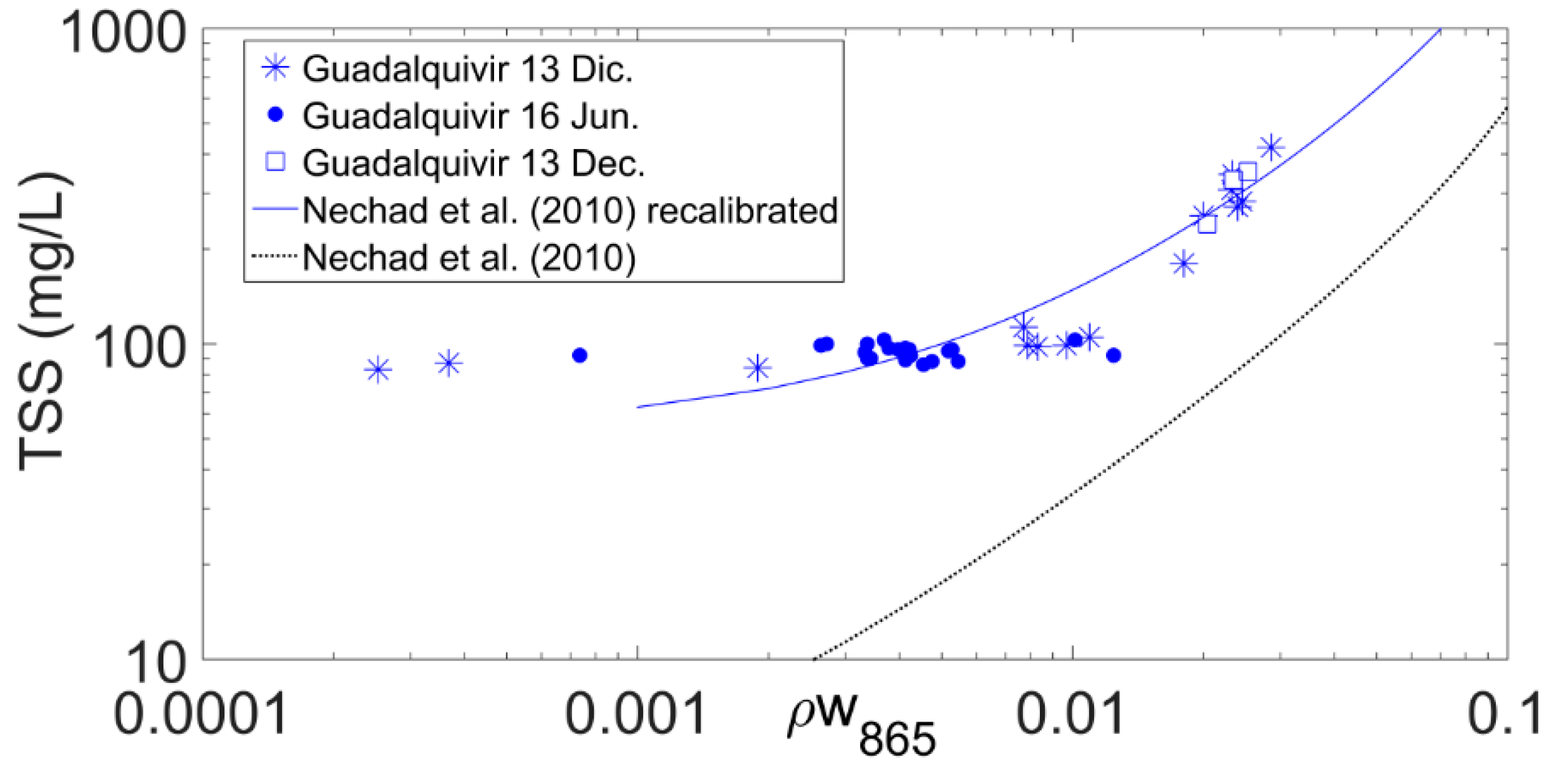
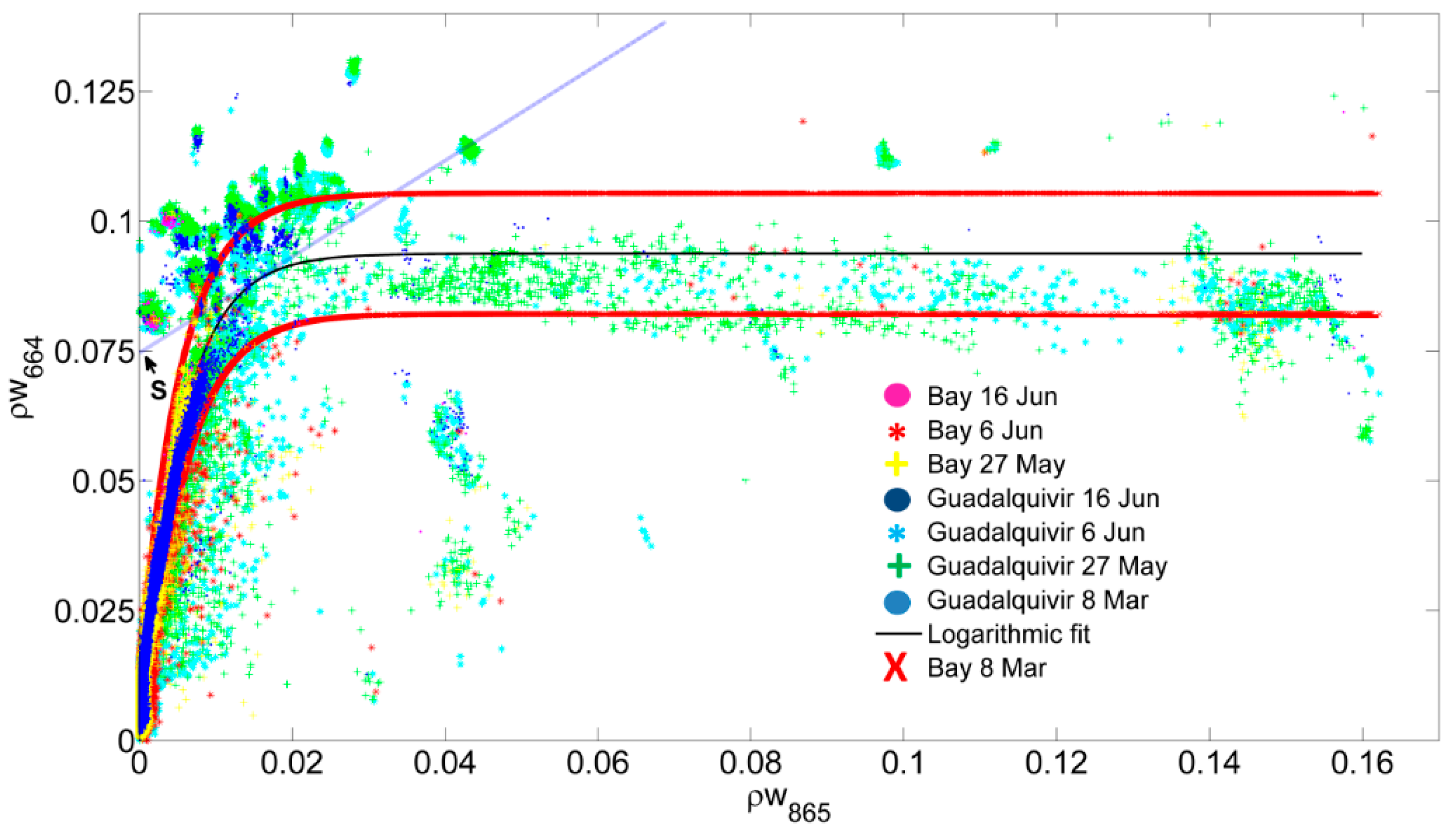
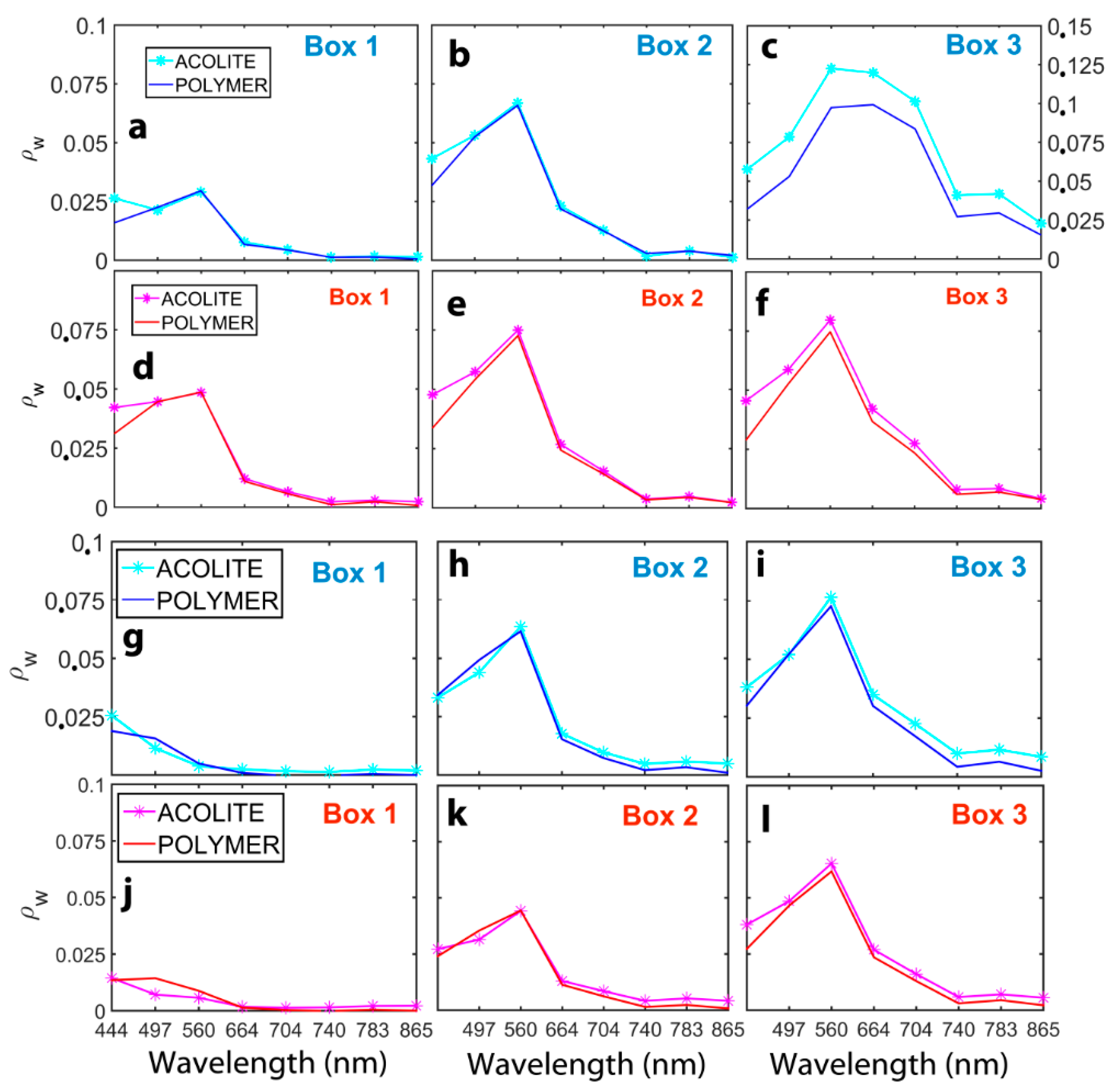
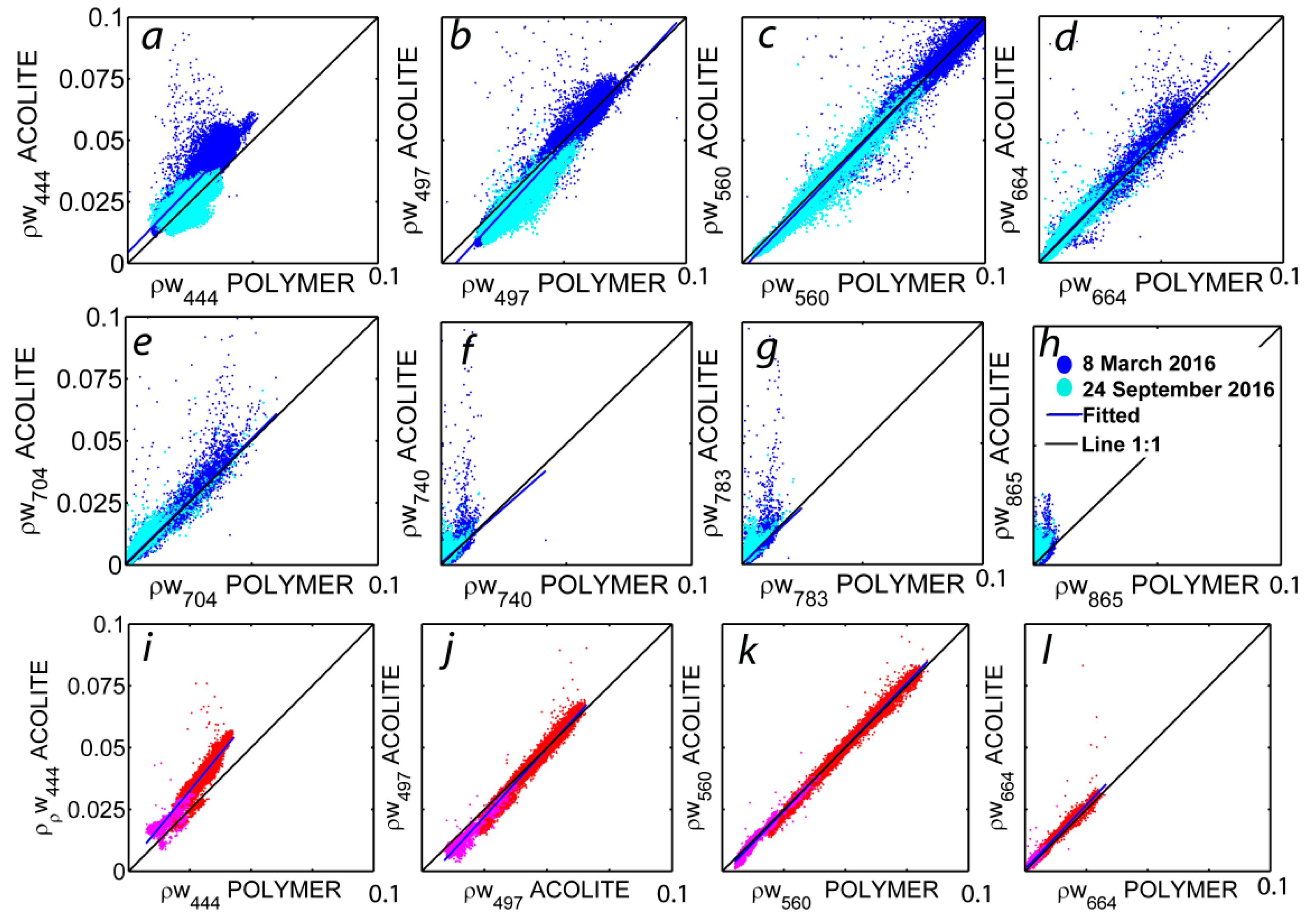

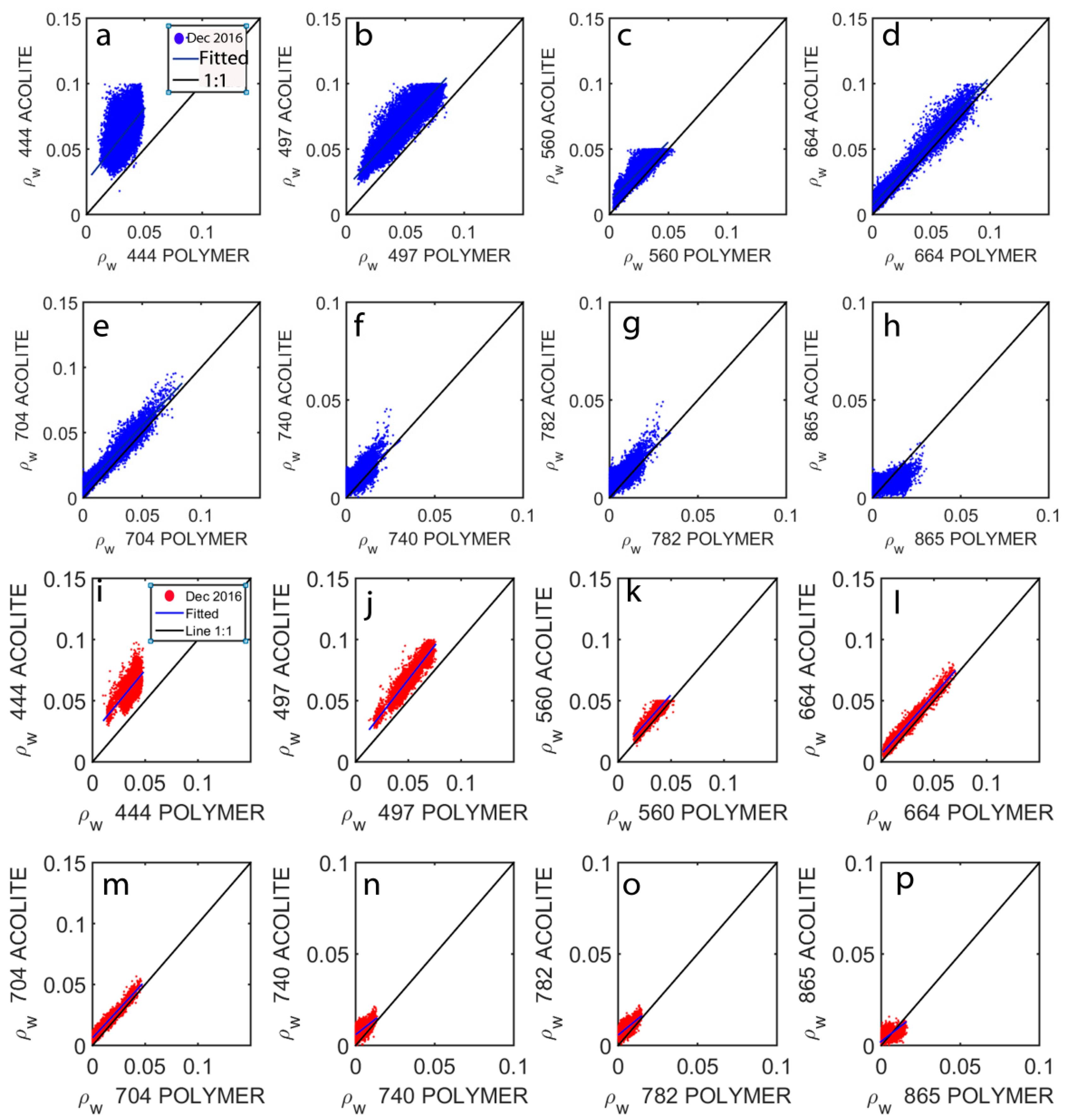
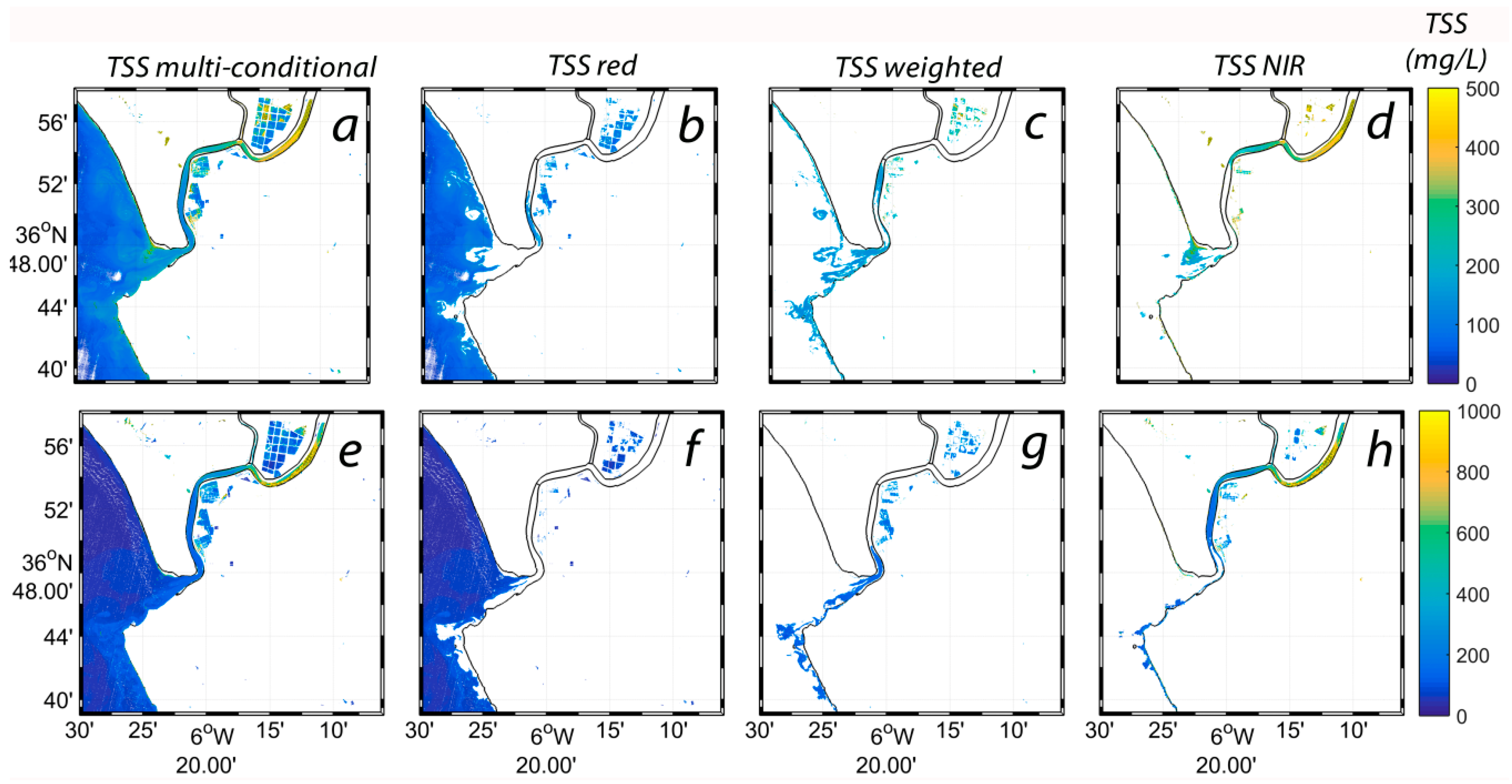
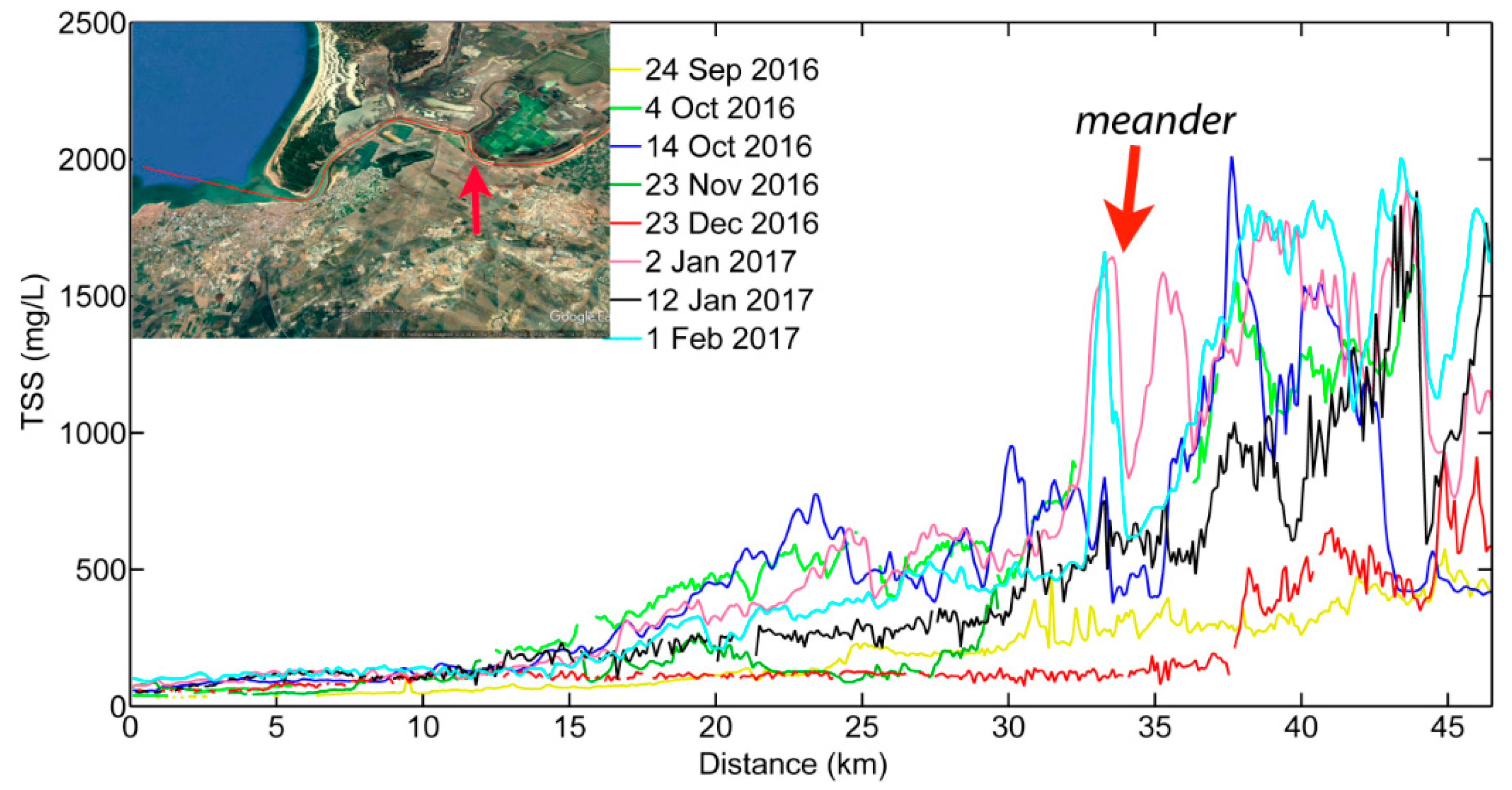
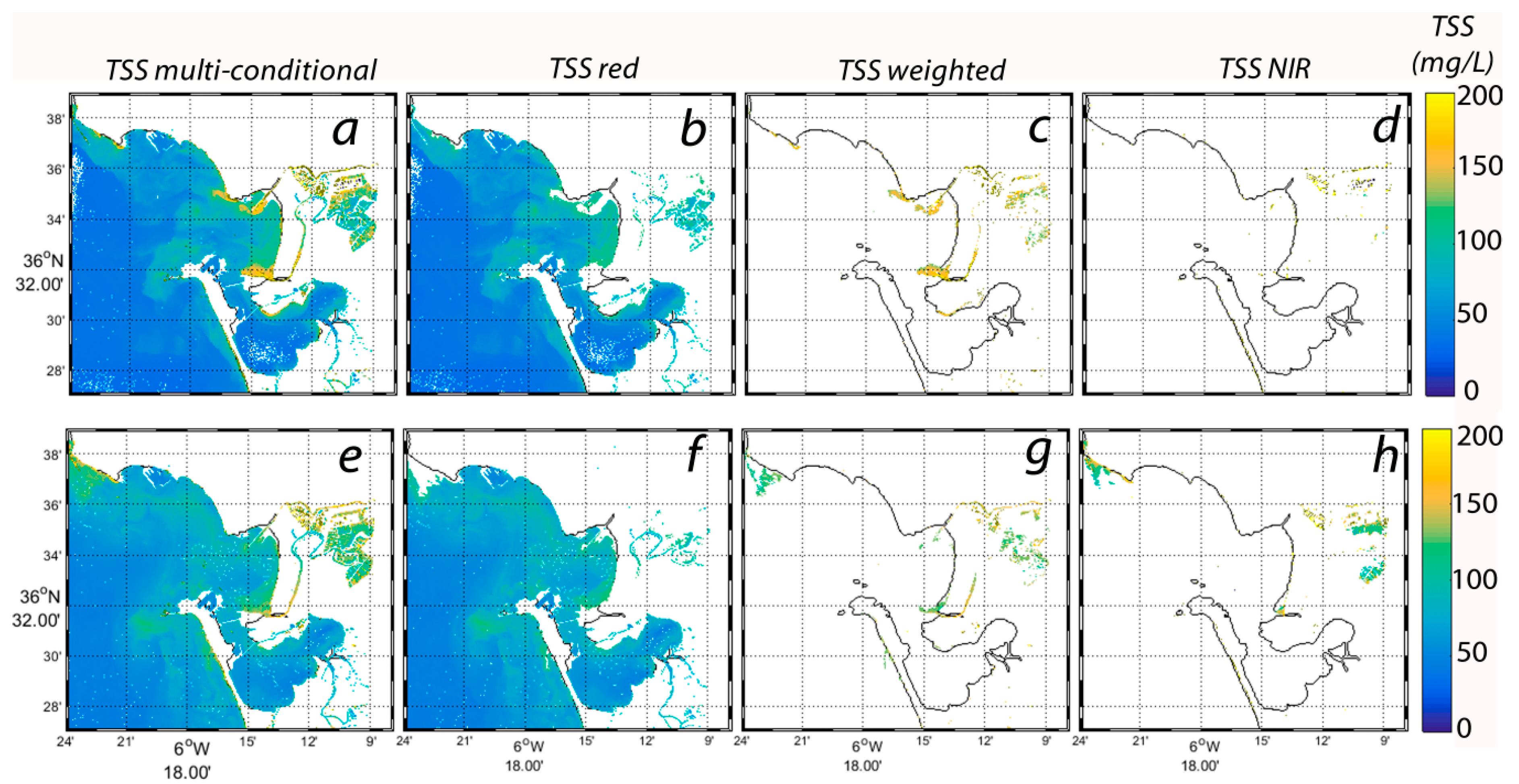
| Number | Date | Sun-Glint | In-situ Measurements (Time Difference) | POLYMER | ACOLITE |
|---|---|---|---|---|---|
| 1 | 29 November 2015 | no | no | no | yes |
| 2 | 19 December 2015 | no | no | no | yes |
| 3 | 17 February 2016 | no | no | no | yes |
| 4 | 8 March 2016 | no | no | yes | yes |
| 5 | 17 April 2016 | no | no | no | yes |
| 6 | 27 May 2016 | moderate | Conil port (<0.5 h) | yes | no |
| 7 | 6 June 2016 | moderate | Cadiz Bay (<0.5 h) | yes | no |
| 8 | 16 June 2016 | high | Guadalquivir (<0.5 h) | yes | no |
| 9 | 6 July 2016 | high | no | no | no |
| 10 | 16 July 2016 | high | no | no | no |
| 11 | 26 July 2016 | high | no | no | no |
| 12 | 5 August 2016 | moderate | no | no | no |
| 13 | 25 August 2016 | moderate | no | no | yes |
| 14 | 4 September 2016 | moderate | no | no | yes |
| 15 | 24 September 2016 | no | no | yes | yes |
| 16 | 4 October 2016 | no | no | no | yes |
| 17 | 14 October 2016 | no | no | no | yes |
| 18 | 23 November 2016 | no | no | no | yes |
| 19 | 13 December 2016 | no | Guadalquivir (<1 h) | yes | yes |
| 20 | 23 December 2016 | no | no | no | yes |
| 21 | 2 January 2017 | no | no | no | yes |
| 22 | 12 January 2017 | no | no | no | yes |
| 23 | 1 February 2017 | no | no | no | yes |
| Algorithm: Red (B4, 664 nm) | Equation | Bias (mg/L) | NRMSE (%) | r |
|---|---|---|---|---|
| Recalibrated semi-analytical * | + 29 | 0.81 | 25.06 | 0.794 |
| Polynomial | 40,980 × ρw6642 − 2499 × ρw664 + 116 | 0.91 | 32.80 | 0.762 |
| Exponential | 7 × exp(19 × ρw664) | 3.19 | 29.62 | 0.761 |
| Algorithm: NIR (B8a, 865 nm) | Equation | Bias (mg/L) | NRMSE (%) | r |
|---|---|---|---|---|
| Recalibrated semi-analytical * | + 44 | 0.57 | 10.28 | 0.974 |
| Polynomial | 568,300 × ρw8652 − 4770 × ρw865 + 100 | 0.62 | 7.11 | 0.961 |
| Exponential | 67 × exp(63 × ρw865) | 1.77 | 7.27 | 0.976 |
| Model Intervals ρw Red | Model Intervals Values | TSS Model |
|---|---|---|
| (0; S95−) | (ρw664 < 0.064) | Recalibrated red |
| (S95−; S95+) S = 0.075 | (0.064; 0.087) | Smoothing interval red-NIR α red + β NIR |
| (S95+<) | (ρw664 > 0.087) | Recalibrated NIR |
© 2018 by the authors. Licensee MDPI, Basel, Switzerland. This article is an open access article distributed under the terms and conditions of the Creative Commons Attribution (CC BY) license (http://creativecommons.org/licenses/by/4.0/).
Share and Cite
Caballero, I.; Steinmetz, F.; Navarro, G. Evaluation of the First Year of Operational Sentinel-2A Data for Retrieval of Suspended Solids in Medium- to High-Turbidity Waters. Remote Sens. 2018, 10, 982. https://doi.org/10.3390/rs10070982
Caballero I, Steinmetz F, Navarro G. Evaluation of the First Year of Operational Sentinel-2A Data for Retrieval of Suspended Solids in Medium- to High-Turbidity Waters. Remote Sensing. 2018; 10(7):982. https://doi.org/10.3390/rs10070982
Chicago/Turabian StyleCaballero, Isabel, François Steinmetz, and Gabriel Navarro. 2018. "Evaluation of the First Year of Operational Sentinel-2A Data for Retrieval of Suspended Solids in Medium- to High-Turbidity Waters" Remote Sensing 10, no. 7: 982. https://doi.org/10.3390/rs10070982
APA StyleCaballero, I., Steinmetz, F., & Navarro, G. (2018). Evaluation of the First Year of Operational Sentinel-2A Data for Retrieval of Suspended Solids in Medium- to High-Turbidity Waters. Remote Sensing, 10(7), 982. https://doi.org/10.3390/rs10070982




